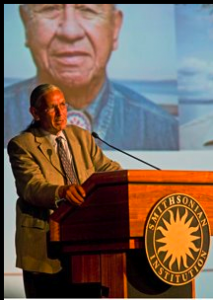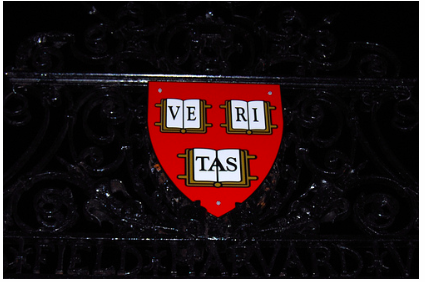By Carol Pierson Holding
How many of us remember the “Crying Indian” from the early 70s? In that public service ad, a Native American (played by an Italian-American actor) canoes down a gorgeous stream, encountering floating trash, smokestacks and a beach littered with refuse. As he passes a crowded highway, a passenger throws garbage out the window. The camera pans to his face, where one tear makes its way down his craggy cheek.
That unforgettable image marked the start of the mass ecology movement and became a symbol almost as powerful as Earth Day. It also reinforced Native Americans as powerless victims of our culture’s wanton appetites.
Last week, some forty years after the Crying Indian, Native Americans are taking matters into their own hands. Four tribes from the Olympic Peninsula in Washington State hosted a symposium in Washington D.C. at the Smithsonian's National Museum of the American Indian to address climate change.
Called “First Stewards: Coastal Peoples Address Climate Change,” this gathering of coastal tribes from all regions in the US and its Pacific Island territories engaged sponsors from US land management services within the US Department of the Interior and partners from environmental organizations such as The Nature Conservancy.
As I read the daily blog from the symposium, I was struck by the heartbreaking stories of tribes whose livelihoods are built on the rapidly disappearing bounty of nature. These embattled peoples are once again suffering the brunt of our collective rapacity, this time in territory degradation and species loss.
But this time, Native Americans insist on being part of the solution. And some elements within our government agree. Daniel J. Basta, director, NOAA’s Office of National Marine Sanctuaries, says, “Coastal indigenous people have internalized thousands of years of rich, place-based knowledge of climate change and its impact on humans, and adaptive behavior. Their experience is extremely valuable today and can help all of us as the world looks for ways to adapt.”
We need knowledgeable people to offer ideas for adaptation. But we also need passionate leaders to lead the fight for a long-term solution. Native Americans have rarely been successful at holding off those with great power from doing exactly what they want. But Natives are angry. Ann Marie Chischilly, an environmental professional and Navaho tribe member, urges fellow Natives, “Get mad! Get motivated and get involved.” And what better symbol in the fight to stem climate change than America’s first inhabitants?
But any good fight requires an antagonist, the more ruthless the better. And who could we blame that could make any real difference? The car companies have already embraced higher mileage requirements and electric cars. Who else is there?
In his cover story for Rolling Stone, “Global Warming's Terrifying New Math,” Bill McKibben suggests a candidate for villain, the oil companies. His “terrifying new math” estimates the value of fossil fuel reserves held by the fossil fuel industry at tens of trillions of dollars. Hence the seemingly endless resources the oil industry spends to stop any attempt to regulate its businesses.
And if we burn all of those reserves as the oil companies and their investors hope? CO2 levels will rise way past the level at which the human race can survive.
Indeed, this all-powerful adversary can only be stopped through a planet-wide moral outrage not seen since the anti-Apartheid movement. McKibben quotes Bob Massie, a former anti-apartheid activist who helped found the Investor Network on Climate Risk:
"Given the severity of the climate crisis, a comparable demand that our institutions dump stock from companies that are destroying the planet would not only be appropriate but effective. The message is simple: We have had enough. We must sever the ties with those who profit from climate change – now."
The successful battle to end Apartheid had its clear villains, Apartheid supporters, its effective change agents in the international investment community, and its victims and symbols, the “non-whites.” We have our bad guys, a group already resented for spills like the Exxon Valdez and the BP Gulf Oil Spill.
[csrhubwidget company="BP-PLC" size="650x100"]
Click "Oil and Gas Extraction" in the CSRHub Sustainability Ratings widget above to see all the companies and their ratings in this industry.
McKibben suggests a divestment strategy kicked off by students outraged either by the threats to their own future or by the same empathy that drove their reaction to Apartheid.
While Natives have not had a lot of success going up against the powerful, they are effective and deeply moving as symbols as was seen with the Crying Indian. Only this time, they’ll be lending their own images in support of their own cause. And images of suffering Natives will be angry instead of sad. And they won’t be actors.
Carol Pierson Holding writes on environmental issues and social responsibility for policy and news publications, including the Carnegie Council's Policy Innovations, Harvard Business Review, San Francisco Chronicle, India Time, The Huffington Post and many other web sites. Her articles on corporate social responsibility can be found on CSRHub.com, a website that provides sustainability ratings data on 5,000 companies worldwide. Carol holds degrees from Smith College and Harvard University.

